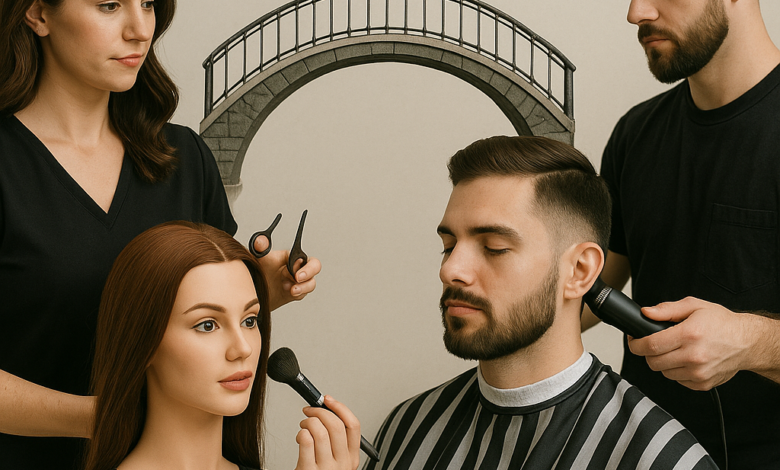From Cosmetology to Barber: A Comprehensive Guide to Barber Crossover and Barber Schools with Financial Aid in Miami

Transitioning from a cosmetology background into barbering unlocks exciting possibilities for career growth, skill diversification, and income expansion. In Miami’s dynamic grooming market, a focused barber crossover pathway can fast-track cosmetologists toward a new license—minus redundant coursework. And if cost is a barrier, numerous barber schools with financial aid options make the journey affordable. This guide walks you through every step: understanding crossover requirements, finding Miami barber academies, exploring financial aid routes, securing funding, and thriving in your new barber training.
Introduction
For many licensed cosmetologists, the idea of adding men’s grooming skills feels both logical and enticing. You already know hair texture, product chemistry, sanitation protocols, and client consultation—yet the state barber exam demands expertise in clipper techniques, straight-razor shaving, facial treatments, and men’s hairline design. The barber crossover concept addresses this gap directly: cosmetology license holders enroll in a streamlined barber program that focuses only on the extra hours and competencies required by the Florida Board of Barbering. No need to redo salon-focused color theory or esthetics modules you’ve already aced.
Meanwhile, Miami’s male clientele has grown savvier and quality-conscious. Modern barbershop lounges offer ritualistic hot towel shaves, beard detailing, and fade artistry—services that command premium rates. By bridging from cosmetology into barbering, you can tap into a broader market and charge accordingly. Yet programs cost thousands of dollars, and full-time enrollment may disrupt current income. Enter barber schools with financial aid: accredited Miami academies that participate in federal aid, state grants, vocational scholarships, and payment plans. With the right guidance, you can secure grants that never need repayment, low-interest loans that defer until after licensure, and targeted scholarships designed for crossover students.
This guide covers:
- Core benefits of a barber crossover for cosmetologists.
- Florida state requirements for barber licensure and how crossover programs align.
- Strategies for identifying reputable barber schools in Miami with financial aid options.
- A detailed breakdown of federal, state, and institutional funding sources.
- Practical advice for submitting strong financial aid applications.
- Tips for excelling in barber training and mastering essential techniques.
- Answers to common questions about timeline, scheduling, and licensure.
Whether you’re weighing a part-time evening program alongside your salon schedule or ready to commit full-time to a six-month barber track, this post equips you with actionable insights. Read on to plan your barber crossover journey and enroll in top barber schools with financial aid in Miami without breaking the bank.
Why Make the Move? The Value of a Barber Crossover
Boosted Income Potential
Cosmetologists often earn by appointment-based styling and coloring services. Barbers, however, can tap into recurring grooming needs—trims every three to six weeks, weekly beard maintenance, and subscription models for grooming packages. Premium services like straight-razor hot towel shaves and precision fades can carry higher price tags. By adding barber services to your offerings, you diversify revenue streams and reduce empty chair time.
Broader Client Base
Salon environments traditionally skew female clientele. Barber shops attract men seeking specialized cuts, ritualistic shaves, and facial treatments. As gender norms around grooming relax, more women also experiment with clipper cuts and edgy styles—further expanding your potential market.
Streamlined Learning Path
The barber crossover route leverages your existing cosmetology license. Instead of repeating 1,200 hours of salon curriculum, you enroll in 150–300 hours of barber-specific coursework. This includes focused study on men’s hair anatomy, straight-razor mechanics, beard design, and state exam preparation.
Entrepreneurial and Creative Freedom
Dual licensure empowers you to work in barbershops, men’s grooming lounges, or open a hybrid salon. You can curate a service menu that blends colored highlights and fades, or launch a mobile barber truck for events and photo shoots.
Professional Credibility
Holding both cosmetology and barber licenses reflects dedication and versatility. Clients and employers value professionals with cross-disciplinary expertise. A barbershop looking to introduce color and chemical services may favor your combined skill set.
Financial Aid Fundamentals for Barber Training (Approx.
Investing in a barber crossover program doesn’t have to come from personal savings. Miami’s accredited academies often participate in multiple funding streams:
Federal Student Aid (FAFSA)
Filing the FAFSA unlocks three main resources:
- Pell Grants: Need-based, up to $7,395 per academic year (2024–25 maximum).
- Direct Subsidized Loans: Interest covered during enrollment for students with demonstrated need.
- Direct Unsubsidized Loans: Available regardless of need; interest accrues immediately.
Action Step: Confirm the school’s Title IV program code, then submit your FAFSA by June 30 for priority consideration.
State Grant Programs
- Florida Workforce Scholarship: Awards up to $5,000 annually for high-demand trade programs, including barbering. Eligibility hinges on household income thresholds and program alignment.
- Florida Bright Futures: If you meet GPA and test benchmarks from high school, you can redirect leftover funds to a barber program—check with school advisors for transfer policies.
Action Step: Compile state grant application deadlines—some close as early as spring term.
Institutional Aid
Barber schools often reserve their own scholarships and tuition discounts:
- Merit-Based Awards: Granted for strong cosmetology academic records or practical skill demonstrations.
- Need-Based Scholarships: Allocated by institutional review boards based on FAFSA data.
- Tool and Kit Stipends: Small awards covering barber kit essentials (clippers, shears, straight razors).
Action Step: Draft a concise personal statement highlighting your cosmetology background, service philosophy, and community involvement.
Workforce & Community Resources
- WIOA Funding: The Workforce Innovation and Opportunity Act helps eligible job seekers (unemployed, veterans, low-income individuals) access training.
- Reemployment Assistance Training (RAT): State unemployment programs may fund barber training to expedite job placement.
- Local Foundations and Nonprofits: Miami-based community organizations sometimes offer micro-grants for vocational students.
Action Step: Contact Miami-Dade County career centers or one-stop workforce offices to determine eligibility and application procedures.
Private Loans and Payment Plans
- Third-Party Lenders: Some schools partner with financing companies offering deferred tuition or low monthly payments.
- In-House Payment Plans: Spread tuition across four to six installments.
Action Step: Review loan terms carefully—compare APRs, origination fees, and deferment policies.
Instituting a multi-pronged funding strategy—combining federal grants, state scholarships, and institutional awards—can cover most or all of your training costs. The key is early research, meticulous deadline tracking, and completing every application fully.
Securing Financial Aid: A Step-by-Step Blueprint
Prepare Documentation
- FAFSA Filing: Gather tax returns, W-2s, and Social Security information.
- Transcripts and Licensure Proof: Submit cosmetology transcripts and active license copy.
- Personal Statement: Craft a two-page essay that connects your cosmetology journey to barbering goals.
- Letters of Recommendation: Two to three references from salon managers, cosmetology instructors, or community mentors.
Craft a Standout Application
- Personal Narrative: Illustrate your passion for men’s grooming, how barber skills complement your cosmetology background, and your long-term vision.
- Portfolio Insert: Include high-quality photographs of coiffures, color work, or editorial styling to showcase technical proficiency and creativity.
- Goal Alignment: For workforce grants, articulate how barber licensure leads directly to employment and economic self-sufficiency.
Meet Deadlines Relentlessly
Create a calendar with:
- FAFSA priority date (as early as October 1 of the preceding year).
- State grant deadlines (often spring or early summer).
- Institutional scholarship cutoffs (varies by school).
- Workforce funding windows (quarterly or by application cycle).
Set reminders two weeks before each deadline to review and polish submissions.
Follow Up Persistently
- Verify Receipt: Call or email financial aid offices to confirm materials.
- Resolve Holds: Clear any FAFSA verification flags quickly by providing requested documentation.
- Appeal If Needed: If initial awards fall short, submit an appeal letter explaining extenuating circumstances (medical bills, family hardship).
Leverage Networking
- Industry Mentors: Ask former cosmetology colleagues now in barber roles for tips on hidden scholarship opportunities.
- School Ambassadors: Connect with current barber students who have navigated aid successfully. They can offer real-world advice on negotiation and application tactics.
Thriving in Your Barber Crossover Training
Establish a Practice Routine
- Daily Skill Drills: Dedicate at least one hour per day to fades, clipper settings, and scissor-over-comb basics.
- Peer Practice Groups: Organize small cohorts for mutual critique and timed styling challenges.
- Technique Journaling: Document blade angles, guard numbers, and client feedback after each session.
Utilize School Resources Fully
- Skills Lab Access: Log extra open-lab hours for tool experimentation and mock exams.
- Instructor Office Hours: Seek one-on-one feedback on weak areas, such as neckline symmetry or blade path consistency.
- Supplementary Workshops: Attend optional masterclasses on advanced techniques (e.g., skin fades, creative part designs).
Build a Professional Portfolio
- Photo Quality: Use a neutral backdrop and consistent lighting to photograph haircuts and shaves.
- Variety of Styles: Showcase fades, crew cuts, taper cuts, beard lineups, and specialty looks.
- Digital Presence: Create a basic website or Instagram account to display your work and attract potential clients or employers.
Develop Soft Skills
- Client Consultation Practice: Role-play scenarios focusing on understanding client preferences, face shape analysis, and style recommendations.
- Time Management: Simulate booking schedules to practice completing cuts and shaves within typical appointment windows.
- Professional Etiquette: Cultivate clear communication, punctuality, and a welcoming demeanor.
Prepare for State Exams
- Mock Theory Tests: Use question banks and flashcards covering sanitation, tool maintenance, and state board regulations.
- Practical Drill Runs: Under timed conditions, perform a men’s taper cut and a straight-razor shave on models to replicate exam stress.
- Peer Judging: Exchange critiques with classmates using official state scoring rubrics.
By integrating deliberate practice, leveraging school supports, and honing both technical and interpersonal skills, you’ll enter the barbering field a confident professional ready to command respect and build a loyal client base.
Conclusion
Embarking on a barber crossover from cosmetology in Miami positions you at the forefront of a booming men’s grooming market. By leveraging your existing license and enrolling in a targeted barber program, you skip redundant coursework, reduce training time, and expand your service offerings. Crucially, barber schools with financial aid ensure cost is no longer a barrier: federal Pell Grants, subsidized loans, state workforce scholarships, and institutional awards can cover much of your tuition and fees.
Act now: research DBPR-approved schools, submit your FAFSA early, and apply for state and institutional scholarships. Draft a compelling personal statement, gather strong references, and track deadlines carefully. Once enrolled, dedicate yourself to deliberate practice, use school resources, and build a standout portfolio. Within months, you’ll be ready to pass the Florida barber exam, earn dual licensure, and serve a wider clientele—boosting your income and professional reputation.
Your journey from cosmetologist to licensed barber begins here. Embrace the opportunity, secure the aid you deserve, and watch your Miami grooming career flourish on a new level.




